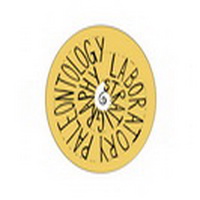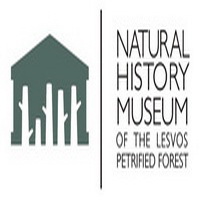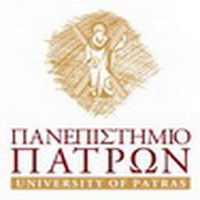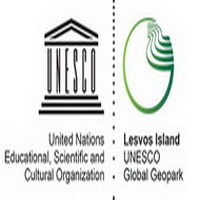Lesvos Petrified Forest
The Lesvos Pertified Forest is one of the most beautiful monuments of our geological heritage worldwide. Remains of fossil plants, declared as Protected Natural Monument, have been found in many localities on the western part of Lesvos Island. The fossilised plants in Lesvos are silicified remnants of a sub-tropical forest that existed on the north-west part of the island 20 million years ago,due totheintensevolcanicactivityinthearea.
The most noteworthy concentrations of petrified trunks, which make up the renowned ‘’Petrified Forest’’ are located in the regions of Sigri, Antissa and Eresos in an area extending over 150 hectares. Aside from petrified trunks, one encounters perfectly preserved petrified roots, fruit, leaves and seeds.
The large number of standing petrified trunks with their root systems intact and in full development provides proof that these trees were petrified in their original position. In other words this is an autochthonous petrified forest.
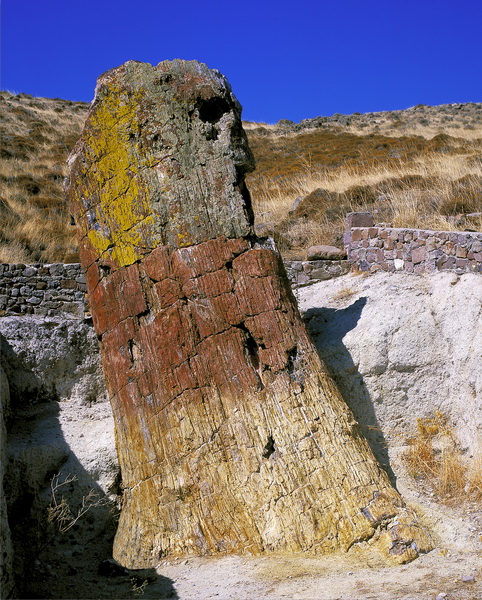
The largest known standing trunk of a sequoia petrified tree in the world.
The Petrified Forest provides considerable information regarding the composition and character of the paleoflora and climatic conditions of the distant past. This monument thus constitutes a natural document recording the geological history of the Aegean basin of the last 20 million years.
Recognising the major environmental, geological and palaeontological value of the site, the Greek State has declared the Petrified Forest to be a preserved Natural Monument (Presidential Decree 443/85). The aim of designating the Petrified Forest as such its more effective protection and rational management of the area.
The visitor of Lesvos has many alternatives concerning the visit of sites with Petrified tree trunks, choosing from the Nissiopi Marine Park, the Petrified Forest Park, the Sigri Park, the Plaka Park and the Natural History Museum of the Lesvos Petrified Forest.
For further information please contact: Natural History Museum of the Lesvos Petrified Forest, Sigri, Lesvos isl. GR-81103, Tel-Fax: +30 2251047033, +30 2253054434, E-mail: This email address is being protected from spambots. You need JavaScript enabled to view it., www.lesvosmuseum.gr, www.petrifiedforest.gr.
Natural History Museum of the Lesvos Petrified Forest
The Natural History Museum of the Lesvos Petrified Forest is situated in Sigri in the westernmost area of Lesvos Island. The Museum was established in 1994 to conserve, protect and promote the fossils which constitute the Petrified Forest of Lesvos.
.jpg)
Natural History Museum of the Lesvos Petrified Forest.
The visit in the Natural History Museum of the Lesvos Petrified Forest is a unique experience. The quantity of the Petrified tree trunks that constitute an entire fossilized ecosystem is impressive and cannot be observed anywhere else in the world.
The two permanent exhibitions of the Museum offer an informative interpretation of the most important facts detailing the evolution of the landscape and life. They tell the story of the large and complex changes that led from the Aegiis landmass to the Aegean archipelago of today and allow visitors to travel back through time, inviting them to feel, contemplate and attempt to comprehend this amazing story of the world. The Museum has the most complete collection of fossilized plants in Greece and offers a complete presentation of all the unique fossils brought to light by the ongoing excavations in Western Lesvos.
The first permanent exhibition hall of the Museum is dedicated to the Lesvos Petrified Forest. This hall displays rare plant fossils from the region of western Lesvos. Information is provided on the process of fossilization and the different types of fossils to be seen in nature. The second hall is dedicated to the geohistorical evolution of the Aegean area, highlighting geological phenomena and processes related to the system of the Earth’s crust that helped create the Petrified Forest.
.jpg)
The Petrified Forest exhibition hall.
In the museum’s premises operates an earthquake simulator, simulating some of the most destructive earthquakes. The earthquake simulator offers visitors a realistic experience of the seismic vibrations, aiming to the understanding of the phenomenon and their preparation in case of an earthquake.
The Museum is the managing body of “Lesvos – UNESCO Global Geopark” and collaborates with the UNESCO Global Geoparks Network, the European Geoparks Network, scientific bodies, museums, universities and research centers from Greece and abroad.
In 2001 it was awarded with the Eurosite management award, for the promotion and management of the Petrified Forest. In 2008 it was awarded with the first international prize of the Skal International Ecotourism Award in the category “Ecotourism destination” whereas in 2009 Lesvos and the Petrified Forest were acknowledged as top tourist destination in Greece, in the frames of the European programme European Destinations of Excellence” (EDEN).
The Museum organizes every year a variety of high level services and special activities like information services, ecotouristic activities, educational programmes, temporary exhibitions, cultural events, the agrotourism festival. The Museum’s facilities are available to scientist for the organization of conferences, seminars, scientific congresses and exhibitions.
For further information please contact: Natural History Museum of the Lesvos Petrified Forest, Sigri, Lesvos isl. GR-81103, Tel-Fax: +30 2251047033, +30 2253054434, E-mail: This email address is being protected from spambots. You need JavaScript enabled to view it., www.lesvosmuseum.gr, www.petrifiedforest.gr.
Lesvos Island UNESCO Global Geopark
Lesvos Island UNESCO Global Geopark has a particularly rich natural environment that has contributed decisively to the development, creation and evolution of societies that flourished over time in this area. The Lesvian nature has been an eternal inspiration to man, who has created here art and culture.
The long geological history of Lesvos is reflected in its complex geological structure and the large number of geosites, such as volcanoes, hot springs, important fossiliferous sites, large geological faults, waterfalls, coastal landforms.
On the western peninsula of Lesvos, the dominating feature is the Lesvos Petrified Forest, a worldwide unique natural monument, which has been declared by the Greek State a «Protected Natural Monument».
Lesvos is also characterised by a rich biodiversity. Due to favourable soil and climatic conditions, it is covered by a very rich flora. With more than 1,400 species and subspecies of plants, the island could be described, without exaggeration, as a «Botanic Paradise»: aromatic-medicinal, ornamental and rare plants, trees and shrubs. The special ecological value of Lesvos is emphasized through the integration of many areas within the European ecological network «NATURA 2000». Three areas have been designated as Special Areas of Conservation (Sites of Community Importance) and 6 areas as Birds Directive Sites (Special Protection Areas).
The natural environment, climatic conditions, fertile soils, hot springs, mineral resources have all created favourable conditions for the settlement of man on Lesvos since the Stone Age. In Lesvos one can find prehistoric and historic archaeological sites, medieval castles, Byzantine monasteries, traditional villages. The rich architectural heritage is associated with the use of local building materials, in their turn associated with the geological history and heritage.
Lesvos is the birthplace of important personalities of literature and the arts, such as the ancient poets Sappho and Alkaios, the philosophers Theophrastus and Pittacus, the famous musician of the 7th century BC Terpandros, as well as of significant contemporary artists, such as the painter Georgios Iakovidis and the Nobel prize awarded poet Odysseus Elytis.
Lesvos offers its visitors the opportunity to experience and visit a network of geosites geo-monuments, the organised parks of the Petrified Forest, significant habitats, archaeological sites and monuments, which reveal the diachronic presence of humans on the island and their close link with the natural environment and resources. Lesvos also offers a network of important museums that cover a variety of subjects. The visitors can participate in agrotourism and ecotourism activities, original educational programs, sea activities, cultural festivals and trekking in the unique natural environment where Aristotle and Theophrastus once walked.
For further information please contact: Mytilene Information Center, 8th November 17, Mytilene, Lesvos isl. GR-81131, Tel-Fax: +30 2251047033, E-mail: This email address is being protected from spambots. You need JavaScript enabled to view it., www.lesvosgeopark.gr.
Sigri
Sigri is a small fishing village in the western part of Lesvos Island. Sigri is located in the western part of the island, 94 km from Mytilene. Sigri is a part of the municipal district of the new municipality of Lesvos and it formerly belonged to the Municipality of Eressos - Antissa. Its current population is approximately 333 inhabitants.
The first written mention of the village is by Strabo, but it is not verified when the settlement was first established in the region. An organized community was already present there after the 14th century, but it was deserted many times during the Ottoman Empire because of the many attacks by pirates. In 1667 Sigri was plundered by the pirate Georgio Maria Vitali. In 1757 Suleiman- pasha built a castle, which stands until today, in the same place where it is speculated that another smaller fortification wall was built earlier by the Gattilousi family (a Genoese family who controlled a number of possessions in the northern Aegean from 1355 until the mid-15th century). At the same time an aqueduct, a mosque, a school, a hamam and an artificial canal carrying water from an adjacent source were operating in Sigri, with the mosque and the hamam standing until today in the village. In 1789 Sigri’s castle had a hundred soldiers and two hundred cannons. In 1823 the habitants of the nearby island of Psara attempted to raid the village, but after they failed the Ottomans proceeded to prosecutions of the Christian population. At the end of the Ottoman rule Sigri was inhabited by Turks while Greeks settled much later, in the early 20th century.
With the 1912 liberation, the castle no longer serves as a Turkish camp and it passes into the hands of the Allies, who use it as a supply base during the First World War. Later, with the population exchange (that is nowadays considered to be a violation of International Law, accordind to the UN), Turkish citizens left Sigri and Greek refugees from Asia Minor settled in the village. These refugees had a tradition of shipping and fishing and merchant ships from Sigri were swarming the Aegean until the Second World War, when their small businesses collapsed. After WWI, between 1950 - 1960 several residents from Sigri left for Athens, and also Australia, USA and Canada.
.jpg)
Aerial photograph of Sigri.
Sigri is located in the dry end of the island of Lesvos fairly lacking in vegetation and agriculture. Its beaches have the most sand of all of Lesbos, contrasting with the rockier and pebble beaches to the east. This area is sparsely populated and only visited by a small number of tourists. It is quite windy, relative to east Lesbos, and even beginners in wind surfing are offered the ideal conditions to learn because of the configuration of the bay waters. The village beach, a near-180 degree sweep of volcanic grey sand, can be reached from the village on foot and within a few minutes.
The 2nd IMERP will take place at Sigri, Lesvos Island, Greece, as shown in the following map:
